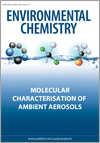EN17188Antimony in the Lot–Garonne river system: a 14-year record of solid–liquid partitioning and fluxes
Environmental context. Antimony is a trace element ubiquitously present in the environment, but data are lacking on its spatio-temporal distribution in aquatic environments. Long-term records serve as essential tools to decipher temporal patterns, historical sources and sinks and background concentrations in an area. We characterise the temporal concentrations, transport and behaviour of antimony in the Garonne River watershed, the main tributary to the Gironde Estuary, the largest estuary in south-west Europe.




